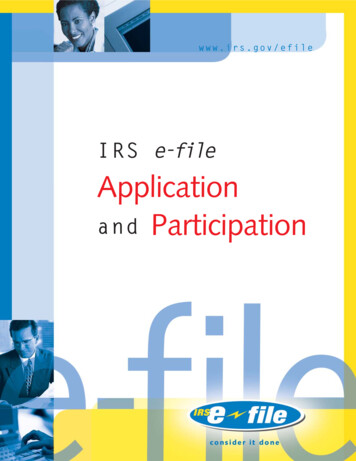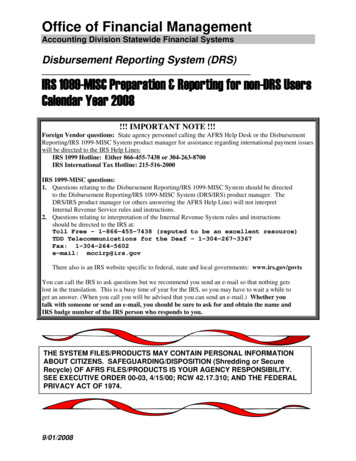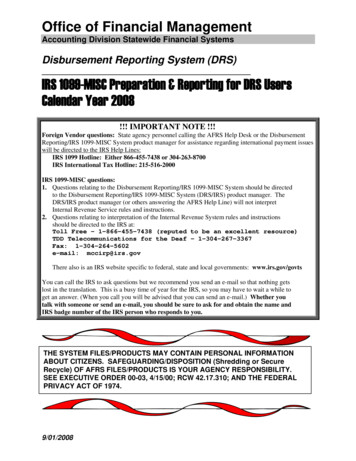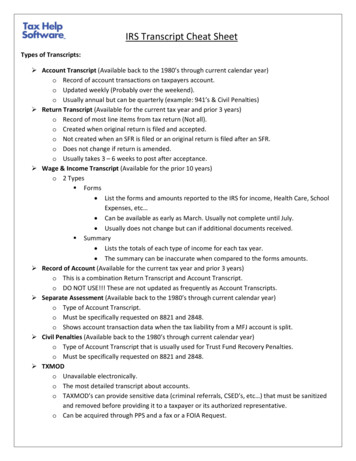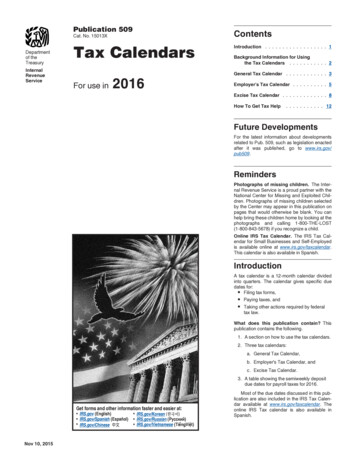
Transcription
Income – Social Security BenefitsIntroductionThis lesson will help you assist taxpayers who have Social Security and equivalent railroad retirementbenefits. These benefits may or may not be taxable.The intake and interview sheet lists Social Security and Railroad Retirement Benefits in the Income section.Ask the taxpayer about the receipt of either of these benefits. The Social Security Administration issuesForm SSA-1099, Social Security Benefit Statement, to Social Security benefit recipients. The RailroadRetirement Board issues Form RRB-1099, Payments by the Railroad Retirement Board, and FormRRB-1099-R, Annuities or Pensions by the Railroad Retirement Board.See Publication 575, Pension and Annuity Income, and Publication 915,Social Security and Equivalent Railroad Retirement Benefits, for additionalinformation on the topics discussed in this lesson.ObjectivesWhat do I need? Form 13614-CPublication 4012Publication 17Optional:At the end of this lesson, using your resource materials, you will be able to: Determine the taxable portion of Social Security and railroad retirementbenefits Determine the most advantageous method of reporting lump sum SocialSecurity benefits Publication 575Publication 915Form RRB-1099Form RRB-1099-RForm SSA-1099 Report Social Security and railroad retirement benefits on the tax returnWhat are Social Security and railroad retirement benefits?Social Security BenefitsSocial Security benefits are payments made under Title II of the Social Security Act. They include Old-Age,Survivor, and Disability Insurance (OASDI) benefits.Social Security benefits include monthly retirement, survivor, and disability benefits. They do not includeSupplemental Security Income (SSI). Certain government retirees who receive a pension from work are notcovered by Social Security.Some portion of the Social Security benefits received may be taxable. Generally, if Social Security benefitsare the only source of income, then the benefits are not taxable. In this instance, taxpayers may not berequired to file a return. However, if the taxpayers are Married Filing Separately and lived with their spouseat any time during the tax year, 85% of the benefits will be taxable.Income – Social Security Benefits14-1
Railroad Retirement Benefits (RRBs)Railroad Retirement Benefits (RRBs) are benefits paid to railroad employees working in jobs that arecovered by the Railroad Retirement Act (RRA). The RRA benefits have two components: tier 1 (SocialSecurity equivalent benefits) and tier 2 (treated as a qualified employee plan). The tier 2 benefits arereported on Form RRB 1099-R. These funds are discussed in the previous lesson on Retirement Income.How are these benefits reported to the taxpayer?Form SSA-1099Social Security benefits are reported on Form SSA-1099. Box 5 shows the amount of net benefits.Taxpayers who did not receive Form SSA-1099, or have misplaced it, may be able to get an instant printoutof benefits from their personal “my Social Security” account on the Social Security Administration website atSSA.gov. Or taxpayers may call toll-free to request a benefit statement to be sent by mail. Social Securityno longer provides benefit verification letters in their offices.Form RRB-1099Tier 1 railroad retirement benefits are equal to the Social Security benefit that a railroad employee orbeneficiary would have been entitled to receive under the Social Security system. These benefits are called“Social Security equivalent benefits” and, for tax purposes, are treated like Social Security benefits. Theyare shown on the blue Form RRB-1099. Box 5 shows the net Social Security equivalent benefits for tier 1.exampleJacob is a retired railroad switchyard operator. Using the intake and interview sheet, the volunteerdetermined Jacob received Railroad Retirement Benefits. He received Form RRB-1099 and FormRRB-1099-R. The amount from Form RRB-1099 will be added to any amount of Social Security benefitsthat he may have received from other employment.When are Social Security benefits and tier 1 RRBs taxable?Part of the following benefits received by the taxpayer may be taxable: Social Security benefits Railroad retirement benefits, tier 1 (Social Security equivalent portion)To correctly calculate the taxable portion, you need to know the amount in Box 5 of Form SSA-1099 orForm RRB-1099. The taxable amount, if any, of a taxpayer’s Social Security benefits depends upon filingstatus and other reportable income. Generally, if Social Security (or Social Security equivalent) benefitswere the taxpayer’s only source of income, the benefits are not taxable and the taxpayer does not need tofile a federal income tax return.A portion of the benefits is taxable if total income (including tax-exempt interest), plus one-half of thebenefits received, is more than certain base income amounts, which vary based upon the taxpayer’s filingstatus. A portion of the benefits is also taxable if the taxpayers are Married Filing Separately and lived withtheir spouse at any time during the year.The taxable portion of Social Security benefits is never more than 85% of the net benefits the taxpayerreceived. In many cases, the taxable portion is less than 50%.If the taxpayer files a joint return, enter the amounts from each Form SSA-1099 and the software willcompute the portion that is taxable, if any.14-2Income – Social Security Benefits
Taxpayers can use Form W-4V, Voluntary Withholding Request, to request withholding from Social Securitybenefits.exampleWanda and Dan are both retired and will file a joint return. Wanda received Form SSA-1099 with anamount of 4,300 appearing in Box 5. Dan retired from the railroad, and Box 5 of his Form RRB-1099shows an amount of 6,800. Wanda and Dan will use the combined benefits of 11,100 and only onecalculation to see if any of their benefits are taxable.How do I report Social Security or railroad tier 1 benefits?Tax Software Hint: The tax software will perform all the calculations to determine the taxable amountbased on other information on the return. Be sure to enter all income, including tax-exempt interest, in orderfor the software to correctly calculate taxability of benefits. Medicare premiums (Part B and D) from FormsSSA-1099 and RRB-1099 may be claimed as a self-employed health insurance deduction if the taxpayer isfiling Schedule C. Otherwise, enter medical premiums so they flow to Schedule A if the taxpayer is itemizingdeductions. Additionally, be sure to enter any federal income tax withholding. Go to the Volunteer ResourceGuide, Tab D, Income, for software entries.EXERCISESAnswers follow the lesson summary.Question 1: Hank comes to your site to get some help with his tax return. He is upset because hisneighbor told him that he would have to pay tax on all of his Social Security benefits this year. Aftertalking to Hank, you learn that his wife died several years ago. This tax year, he sold all of his stockand moved into senior housing. The sale of the stock created 31,896 of taxable income for Hank. Hisneighbor told him, with that much income, the entire 11,724 of his Social Security benefits would betaxable. What is the maximum taxable amount of Hank’s benefits?A. 31,896B. 20,172C. 11,724D. 9,965What are lump-sum benefit payments?Some taxpayers may have received a lump-sum benefit payment. This payment could be for the currenttax year and for prior tax years. Box 3 of the taxpayer’s Form SSA-1099 or Form RRB-1099 will include thelump-sum payment. The form will also show the year, or years, of the payment. The additional informationwill be shown in Description of Amount in Box 3 on Form SSA-1099 or in Boxes 7–9 on Form RRB-1099.Do not confuse this type of lump-sum benefit payment with the lump-sum death benefit that both the SSA andRRB pay to many of their beneficiaries. No part of the lump-sum death benefit is subject to tax.Income – Social Security Benefits14-3
When figuring the taxable portion of Social Security benefits, two options are available for lump-sum benefitpayments: The first option allows the taxpayer to report the whole payment the year it was received. When thetaxpayer chooses this option, complete the Social Security Benefits Worksheet as usual by including theentire lump-sum payment on line 1. The second option is to treat the payment as received in the earlier year or years. This is done byfiguring whether any part of these benefits is taxable, based on the earlier year’s income. Any part thatis taxable is then added to any taxable benefits for the current year and included on Form 1040. Thetaxpayer can elect this method if it lowers the taxable benefits.Will the lump-sum election method lower taxable benefits?Figuring the taxable benefits under the lump-sum election method is in scope for the VITA/TCE programs.If the taxpayer chooses the second option, only the current year income will be adjusted. You do not fileamended returns for the earlier years.Under the lump-sum election method, refigure the taxable part of all the benefits for the earlier year(including the lump-sum payment) using that year’s income and filing status; then subtract any taxablebenefits for that year that were previously reported. The remainder is the taxable part of the lump-sumpayment and is added by the software to the taxable part of the benefits for the current year (figured withoutthe lump-sum for the earlier year).In order to compute the taxable benefits, you will need copies of the taxpayer’s prior year returns.For additional information on the lump-sum election, see Publication 915.exampleLast year, Jane applied for Social Security disability benefits but was told she was ineligible. Sheappealed the decision and won. This year, she received a lump-sum payment of 6,000, of which 2,000was for last year and 4,000 was for the current year. Jane also received 5,000 in Social Securitybenefits in the current year, so her Form SSA-1099 shows benefits paid of 11,000.Jane had other taxable income in both the previous year and the current year. She should figure hertaxable benefits under the lump-sum election method to see if it is lower.Because the earlier year’s taxable benefits are included in the current year’s income, no adjustment is made tothe earlier year’s return. Do not file an amended return for the earlier year.Once a taxpayer elects this method of figuring the taxable part of a lump-sum payment, the election can onlybe revoked with the consent of the IRS.Tax Software Hint: The tax software will figure all the calculations after you enter the prior yeartax return information. Go to the Volunteer Resource Guide, Tab D, Income, Form SSA-1099 Lump SumDistributions, for software entries.14-4Income – Social Security Benefits
SummaryThis lesson explained how to determine whether income from taxpayers’ Social Security benefits andrailroad retirement benefits is taxable.Generally, if Social Security benefits were the taxpayer’s only source of income, the benefits are not taxableand the taxpayer does not need to file a federal income tax return. If the taxpayer received Social Securitybenefits and other income, the Social Security Benefits Worksheet found in the Form 1040 Instructions iscompleted by the software to calculate the taxable portion.When figuring the taxable portion of Social Security benefits, two options are available for lump-sum benefitpayments. The taxpayer may report the whole payment in the year it was received or treat the payment asreceived in the applicable earlier year or years.TAX LAW APPLICATIONTo gain a better understanding of the tax law, complete the practice return(s) for your course of studyusing the Practice Lab on L<.If you are unable to complete the entire exercise, complete as much as you can. Come back later tofinish the exercise after you cover all the technical topics in later lessons.EXERCISE ANSWERSAnswer 1: D. 9,965 or 85% of the net benefits is the maximum amount that could ever be taxable.Income – Social Security Benefits14-5
Notes14-6Income – Social Security Benefits
Generally, if Social Security (or Social Security equivalent) benefits were the taxpayer's only source of income, the benefits are not taxable and the taxpayer does not need to file a federal income tax return. A portion of the benefits is taxable if total income (including tax-exempt interest), plus one-half of the




